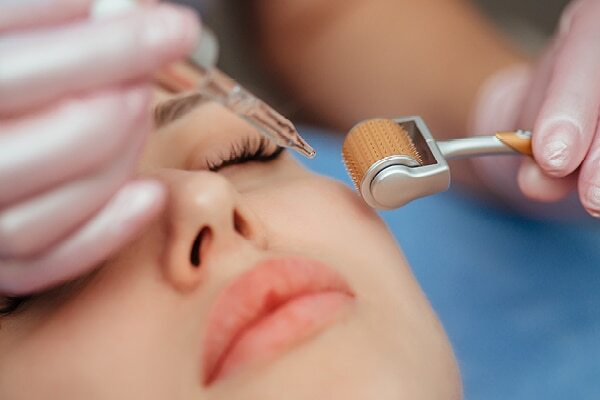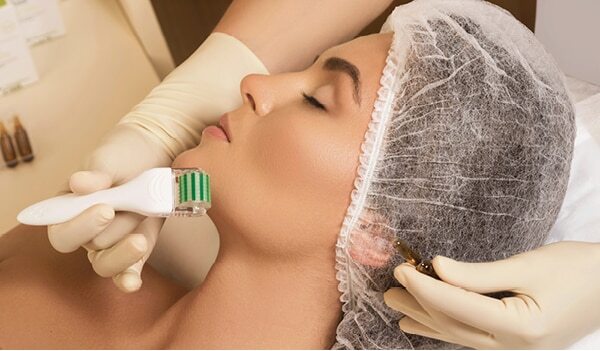A dermaroller is a tool that is often used in microneedling procedures - made up of hundreds of microneedles, it is used to create micro-injuries on the skin. The use of dermarollers was strictly clinical when they first started out, but have seeped into at-home routines as well. And while dermarolling is a safe procedure, it is not recommended to be carried out at home. According to our in-house expert, Dr. Sadhana Deshmukh, "As the name suggests, dermarollers are facial rollers consisting of needles of varying length and thickness. It is primarily a clinical treatment and helps stimulate collagen in the skin, leading to collagen remodelling. It is also designed to help deal with thick skin texture and resurface it superficially, making it useful for fading acne scars. It is a superficial treatment, not very deep; but I would still not recommend it to be done at home, due to chances of unwanted infections."
01How does a dermaroller work?

As mentioned earlier, dermarolling is a clinical and cosmetic procedure where hundreds of tiny little needles are rolled onto the surface of the skin. This results in the infliction of microscopic wounds that boost collagen and elastin production. According to Dr. Deshmukh , "With each stroke, the dermarolling device uses the pin-point technique leading to stimulate healthy collagen in the skin. This helps with collagen remodeling and resurfacing of the skin and achieves its many benefits. Dermarolling procedures are further enhanced by using a serum or PRP technology to achieve a wide number of benefits." Even though it sounds scary, dermarolling is considered a non-invasive and a fairly safe procedure. This is because the wounds made by them are microscopic and superficial. When performed by a professional, the injuries are made in a controlled manner, helping break down scar tissue and benefitting from the subsequent natural wound healing action of your body.
02How does dermarolling benefit your skin?

By now you might have some idea of how dermarolling works on the skin. The main collagen-boosting action is what draws beauty enthusiasts to this treatment because collagen is the key protein responsible for maintaining healthy skin. This naturally occurring protein starts to deplete in the human body post the age of 20, the effects of which start to show on your skin. The puncturing action of dermarollers, paired with other types of add-ons like potent serums and PRP, gets the following reaction from your skin:
- Breaking down of scar tissue to promote healing
- Resurfacing of the top layer of the skin to boost firmness
- Fading of fine lines and wrinkles
- Reduction or pore size and sebum regulation
- Fading of stretch marks
03What to expect from a dermarolling session?

Similar to other non-invasive clinical treatments, dermarolling is a pretty quick procedure. Lasting anywhere between 30 minutes to an hour, here is what you can expect from a standard dermaroller treatment: Step 01 : Every dermarolling session is preceded by sanitising and disinfecting the rollers in a solution of isopropyl alcohol for 5-10 minutes. This is done to keep any unwanted bacterial infections at bay. Step 02 : Once the rollers are sanitised and ready, the professional will move on to thoroughly cleaning and disinfecting your skin as well. The bacteria on your skin can lead to infections as well, especially if you have choses longer needles for the session. Step 03: Once your face is cleansed thoroughly, a numbing cream is applied to your face and left on depending on an individual's pain tolerance. This cream is then wiped off completely before the next step. **Step 04: **After the numbing cream, a serum may or may not be applied to the face to start the dermarolling. The face is divided into sections and each of them is stroked according to the skin issue at hand. Step 05: In the final step, the face is gently cleansed with water and followed up with a basic skincare routine - just the essentials like moisturiser and SPF. It is not advisable to apply exfoliants or active ingredients on the face post a session of microneedling. FYI, you might notice some minor swelling, redness or pulsing of the skin post-treatment; do not stress over it as these conditions will subside after a few days. In the meanwhile, follow a good skincare routine and do not pick at any flaking!
04How long does dermarolling take to work?

Since the main goal of dermarolling is to boost collagen production, the time taken can vary greatly from person to person. Collagen remodelling is a slow process and entirely dependent on your skin type, which means you cannot put a time stamp on it. The time taken will also depend on the kind of roller you have chosen for your treatments and how often you go in for the sessions. On average, results have been known to show up anywhere between 2-6 months. However, this duration is largely dependent on the kind of microneedling procedure you have chosen, the length of the needles and the skin issue you are targeting. For instance, skin issues like hyperpigmentation or wrinkles can require more sessions as compared to others, deciding on the frequency is entirely up to you.
05Expert tips and best practices for dermarollers

- Dermarollers are not recommended to be used at home, most dermatologists agree.
- Avoid going into the sun right after a dermarolling treatment as it can cause tanning and pigmentation.
- Include skin repair and rejuvenation ingredients in your post care routine; ingredients like niacinamide and hyaluronic acid can come in handy.
- Make sure to not skip the SPF following the treatment as the treatment will heighten your sensitivity to the sun.
- Use some skin ice packs to bring down any painful inflammation post the treatment.
06FAQs about dermaroller

1) Are there any side effects of dermarolling?
**A. **Similar to any clinical skin treatment, dermarolling can have side effects as well. However, these side effects can arise from bad practices than the procedure itself. Some of the adverse effects of a dermarolling session gone wrong are skin irritation, bruising, peeling, bleeding and painful infections.
2) Can I use a vitamin C serum after dermarolling treatment?
**A. **Yes, vitamin C is one of the best serums to use. Infused with amazing anti-ageing benefits, it can help enhance the results of the treatment tremendously. However, it is recommended that you wait a couple of days after the session to apply ascorbic acid on your face. Your skin will already be a lot sensitised and the low pH of vitamin C serums can irritate your skin further.
3) Do dermarollers help tighten skin?
**A. **Yes, since dermarolling boosts collagen and elastin in the skin, it can target loose patches and help tighten saggy skin. The treatment can also be applied to other parts of the body to help tighten it, consult your dermatologist as to which one will be right for you.
4) Can dermarolling make you break out?
**A. **It is often advised to not use dermarollers on active breakouts as it can cause the bacteria to spread out and cause more acne. Do not opt for a dermarolling treatment if you have active lesions on your face. However, the treatment is excellent at dealing with acne scars, but make sure you pick the right time for it, which is after the acne has been healed.








